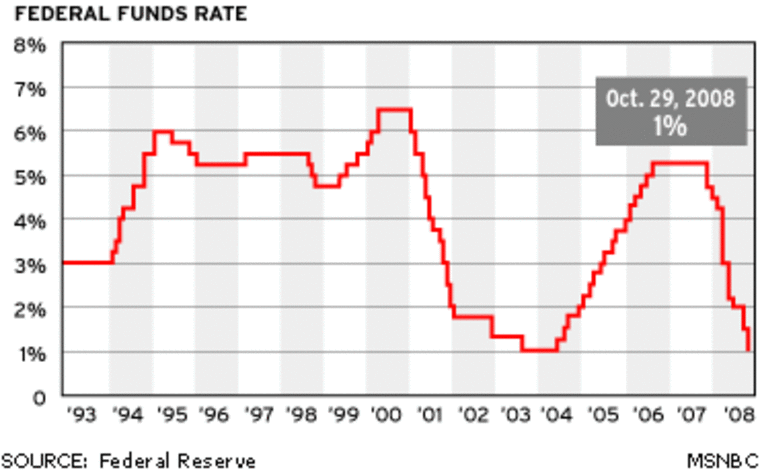Worried about rising prices for gasoline, groceries and other things? Federal Reserve policymakers are, too.
With inflation moving higher on its list of troubles, the Federal Reserve held interest rates steady Wednesday, ending nearly a year of cuts to bolster the economy, and hinted that the next direction for rates could be up.
Fed Chairman Ben Bernanke and all but one of his central bank colleagues agreed that the best course was to leave a key rate alone at 2 percent, as the country slogs through the crosscurrents of plodding economic growth and zooming energy and food prices that threaten to spread inflation.
That meant the prime lending rate for millions of consumers and businesses stayed at 5 percent. The prime rate applies to certain credit cards, home equity lines of credit and other loans.
The decision brought to a close a powerful series of rate reductions that started in September and extended through late April. It was the central bank’s most aggressive intervention in two decades to shore up an economy bruised by the trio of housing, credit and financial crises.
On Wall Street, stocks ended with a modest gain. The Dow Jones industrial average closed up 4.40 points to 11,811.83. Broader stock indicators managed to log stronger gains than the blue chips.
The Fed said it believes its rate cuts will “promote moderate growth over time” as they work their way through the economy. It also said risks that economic growth will falter appear to have “diminished somewhat.”
At the same time, the Fed expressed heightened concern about inflation.
“Upside risks to inflation and inflation expectations have increased,” the Fed said. Inflation eats into paychecks, corporate profits and erodes the value of investments. It is hard to control once it gets out of hand.
Some Wall Street investors and economists think the Fed, to fend off inflation, might be forced to start boosting rates as early as its next meeting on Aug. 5 or toward the end of this year — possibly at the Dec. 16 meeting.
Others, however, think that’s a situation the Fed would like to avoid — especially given that the housing market is stuck in a deep slump, foreclosures are at record highs and jobs are harder to find. Raising rates too soon could hurt housing and deal a setback to the national economy. Those analysts believe the Fed won’t start to push up rates until next year.
The Fed didn’t signal that a rate increase was imminent, instead leaving the timing open.
However one member — Richard Fisher, president of the Federal Reserve Bank of Dallas, wanted to increase rates at Wednesday’s meeting. Fisher, who has a reputation for being extra vigilant on inflation, was the sole dissenter.
“The needle is shifting more to greater concerns over inflation as opposed to economic growth,” said Lynn Reaser, chief economist at Bank of America’s Investment Strategies Group. “That means the Fed’s next move in interest rates will be up but the Fed left its options open with respect to timing.”
Although Fed policymakers believed the economy would eventually gain traction, they acknowledged that conditions are delicate and the economy is not yet out of the woods.
“Labor markets have softened further and financial markets remain under considerable stress,” the Fed said. “Tight credit conditions, the ongoing housing contraction, and the rise in energy prices are likely to weigh on economic growth over the next few quarters.”
The economy has grown at a snail’s pace in recent months. And employers have cut jobs every month so far this year. The unemployment rate jumped from 5 percent in April to 5.5 percent in May, the largest one-month increase in two decades. The unemployment rate is expected to keep on rising in the months ahead, even if economic growth improves somewhat.
Hours before the Fed’s decision, the government released a report underscoring the depth of the housing slump. New-home sales fell 2.5 percent in May, while home prices were down 5.7 percent from a year earlier, the Commerce Department said.
Mortgage rates are rising — spurred by investors’ concerns about inflation. Those higher rates spell yet more headaches for the flailing housing market.
In a string of speeches over the past few weeks, Bernanke and his colleagues have ramped up tough anti-inflation talk. They’ve done that to rein in inflation expectations of consumers, investors and businesses. If those groups think prices will keep on rising, they’ll act in ways that can worsen inflation.
Bernanke, in a rare public utterance for a Fed chief, also has sounded a warning that the slide in the U.S. dollar could contribute to a rise in inflation. He has sought to use words — instead of action — to bolster the dollar and try to lessen inflation pressures.
Consumer prices in the first five months of this year have risen at an annual rate of 4 percent. That’s down from a 4.1 percent increase last year — the biggest jump in 17 years — but is still too high for the Fed’s liking. Gasoline prices and oil prices have set a string of record highs. Gas has topped $4 a gallon, while oil prices are at $134.55 a barrel.
The Fed said it expects inflation to moderate later this year and next but said rising prices for energy, food and other commodities are a cause of concern. Those increases have made people boost their inflation expectations. Thus, “uncertainty about the inflation outlook remains high,” the Fed said.
